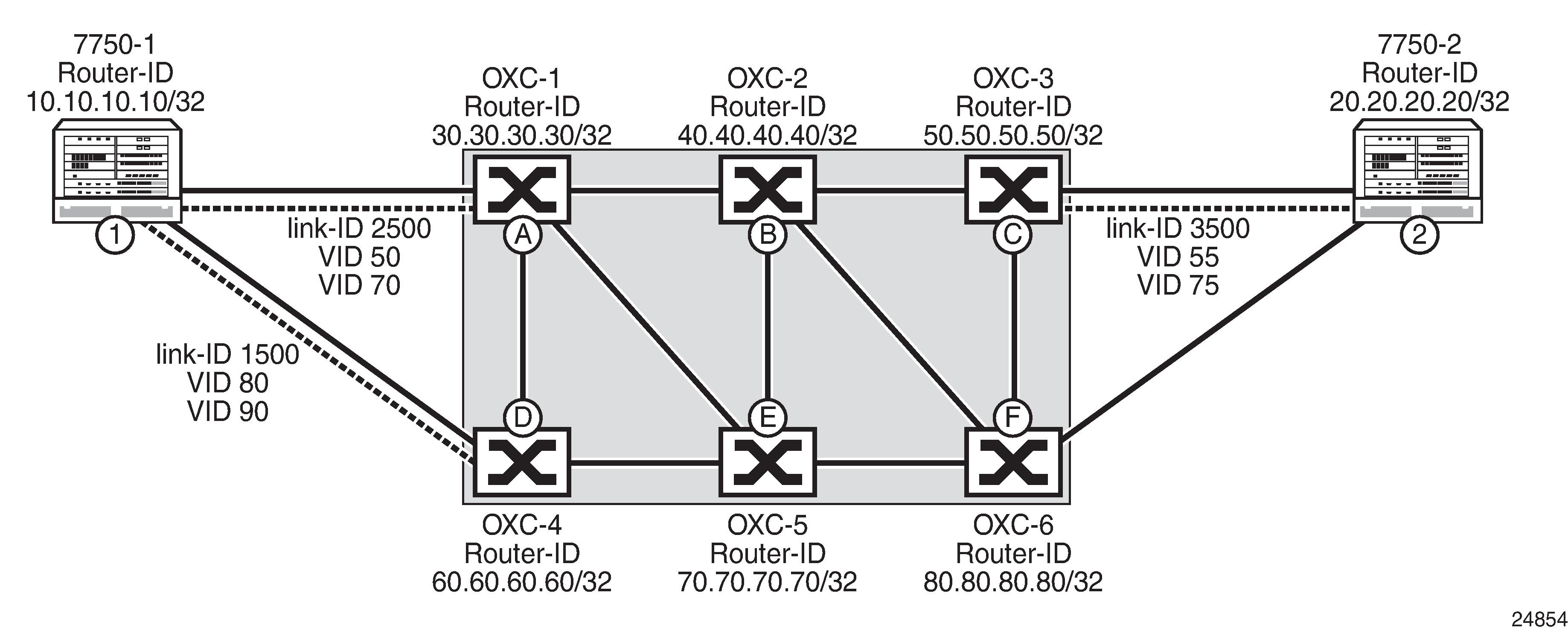Shared Risk Link Groups (SRLG) are used in the context of a gLSP to ensure that diverse paths can be taken for different gLSPs through the optical network. For example, consider the network shown in Figure 1:

In this dual-homing scenario, the primary gLSP takes TE-Link 1-A, and C-2, while the secondary gLSP path takes TE-Links 1-D and F-2. To ensure that a failure in the underlying optical network does not affect both the primary and secondary paths for the gLSP, the SRLG list used by the optical network for the primary path is shared with the UNI-C (1) by the UNI-N (A) at the time the gLSP is established along the primary path. When the secondary path is signaled, the UNI-C (1) signals the SRLG list to avoid to the UNI-N (D). Note that a similar procedure is beneficial even if a UNI-C is not dual homed to the optical network, but diverse primary and secondary paths are required through the optical network.
The 7750 SR and 7950 XRS routers support two methods for indicating a set of SRLGs to exclude:
Explicit configuration of an SRLG list for a gLSP path. These are signaled in the XRO of the RSVP PATH message toward the optical network
Automatic SRLG collection for a gLSP, using the procedures specified in draft-ietf-ccamp-rsvp-te-srlg-collect-04.txt, and operate as follows:
Retrieving SRLG information from a UNI-N for an existing gLSP Path — When a dual-homed UNI-C device intends to establish a gLSP path to the same destination UNI-N device via another UNI-N node, it can request the SRLG information for an already established gLSP path by setting the SRLG information flag in the LSP attributes sub-object of the RSVP PATH message using a new SRLG flag. This path would be the primary path for a gLSP established by the router UNI-C. As long as the SRLG information flag is set in the PATH message, the UNI-N node inserts the SRLG sub-object as defined in draft-ietf-ccamp-rsvp-te-srlg-collect-04.txt into the RSVP RESV message that contains the current SRLG information for the gLSP path. Note that the provider network's policy may have been configured so as not to share SRLG information with the client network. In this case the SRLG sub-object is not inserted in the RESV message even if the SRLG information flag was set in the received PATH message. Note that the SRLG information is assumed to be always up-to-date by the UNI-C.
Establishment of a new gLSP path with SRLG diversity constraints — When a dual-homed UNI-C device sends an LSP setup requests to a UNI-N for a new gLSP path that is required to be SRLG diverse with respect to an existing gLSP path that is entering the optical network via another UNI-N, the UNI-C sets a new SRLG diversity flag in the LSP attributes sub-object of the PATH message that initiates the setup of this new gLSP path. This path would be the protect path of a gLSP established by the router. When the UNI-N receives this request it calculates a path to the destination and uses the received SRLG information as path computation constraints.
The router collects SRLG by default. SRLG collection occurs on all paths of the gLSP. The collected SRLG list is visible to the user via a show command. The recorded SRLGs are then used to populate the XRO. Only best effort (loose) SRLG diversity is supported.
Automated SRLG diversity is supported for the working and protect paths of the following end to end protection types:
1:N
LSPs that form a part of a load sharing tunnel group
Already-established gLSPs within a load-sharing tunnel group or for which 1:N recovery is configured can be made mutually diverse by applying a shutdown / no shutdown operation. GMPLS LSPs with other types of protection can be made mutually SRLG-diverse by performing a shutdown of the gLSP, reconfiguring the SRLG list to exclude using the exclude-srlg command, and then applying a no shutdown of the gLSP.